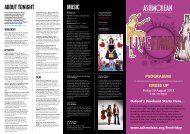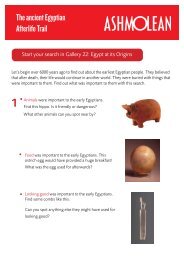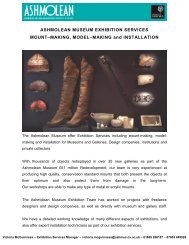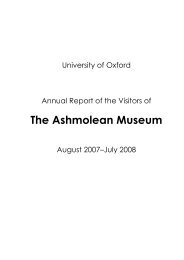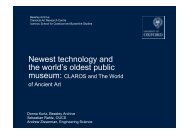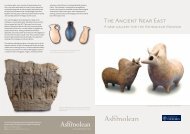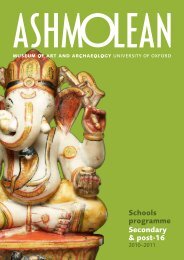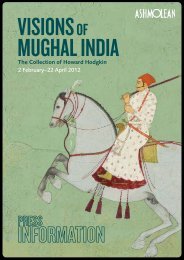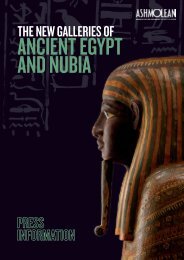A N N U A L R E P O R T - The Ashmolean Museum
A N N U A L R E P O R T - The Ashmolean Museum
A N N U A L R E P O R T - The Ashmolean Museum
Create successful ePaper yourself
Turn your PDF publications into a flip-book with our unique Google optimized e-Paper software.
36 / Highlights of the Annual Report 2004–05<br />
Bronze container in the form of a South<br />
Indian temple<br />
Tamilnadu, South India, 17 th –18 th century. H. 25 cm.<br />
This bronze model of a South Indian Siva temple<br />
serves, in one half, as a container of some kind,<br />
with a hinged lid. Its other half bears the vimana<br />
temple superstructure with figures of Siva, Parvati<br />
and their sons Ganesa and Karttikeya at the<br />
cardinal points, as well as bulls. This very unusual<br />
and interesting temple model formerly belonged to<br />
the late Dr J C Harle, who was Keeper of Eastern<br />
Art (1967–87) and a leading authority on Indian<br />
art and architecture.<br />
Chalgrove II Hoard with coin of Domitianus II<br />
4957 Roman base silver coins, from 251 to 279 AD, in a Roman grey ware jar.<br />
Acquired for £40,000 from the Department of Culture, Media and Sport, with a<br />
contribution of £20,000 from the National Art Collections Fund and additional<br />
support from the Headley Trust for Treasure, the V&A/MLA Purchase Grant Fund,<br />
the Carl & Eileen Subak Family Foundation, and the Friends of the <strong>Ashmolean</strong>.<br />
<strong>The</strong> hoard, found less than ten<br />
miles from Oxford, contained a<br />
truly remarkable coin of an<br />
unknown Roman emperor of the<br />
early 270s AD called<br />
Domitianus. Brian Malin, who<br />
found the hoard, brought it in to<br />
the <strong>Ashmolean</strong> with admirable<br />
care and promptness. <strong>The</strong> coins<br />
were sent to the British <strong>Museum</strong><br />
to be separated and cleaned. An<br />
initial sorting of the coins was<br />
undertaken by Richard Abdy at<br />
the British <strong>Museum</strong>, and it was<br />
he who discovered the<br />
Domitianus coin. <strong>The</strong><br />
<strong>Ashmolean</strong> is very grateful to<br />
both of them.




